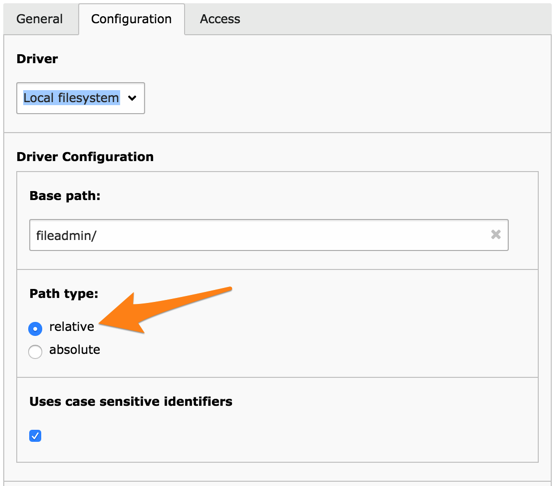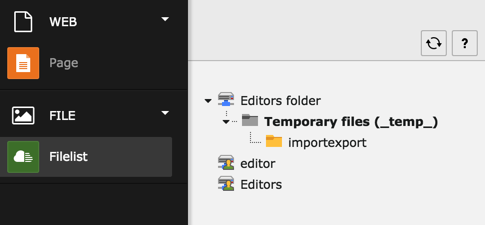Attention
TYPO3 v9 has reached its end-of-life September 30th, 2021 and is not maintained by the community anymore. Looking for a stable version? Use the version switch on the top left.
You can order Extended Long Term Support (ELTS) here: TYPO3 ELTS.
More About File Mounts¶
File mounts require a little more description of the concepts provided by TYPO3 CMS. All files are handled by an application layer called the "File Abstraction Layer" (FAL). You can find more information about the basic concepts of FAL.
The FAL is comprised of the following components:
- Drivers
Drivers are what makes it possible to access a given type of media storage. The Core provides a driver to access the local file system. Extensions exist that provide a driver for remote systems, like SFTP or platforms like Amazon S3.
- Storages
A File Storage uses a driver to connect to a given storage system. It is defined by a path pointing into that storage system. There can be several storages using the same driver and pointing to different "directories". The storage configuration depends on the driver it uses.
Thanks to the storage and its driver, the user is able to browse files from within the TYPO3 CMS backend as if they were stored locally.
- File Mounts
As discussed before, a file mount is the element which is used to actually give access to users to some directories. A file mount is always related to a storage.
Paths for Local Driver Storage¶
The File Storages based on the "local file system" driver have an option for relative or absolute paths.

"Relative" means that the given path is relative to the fileadmin/
folder (or whatever other folder was configured using
$GLOBALS['TYPO3_CONF_VARS']['BE']['fileadminDir'].
Absolute paths are full paths starting at the root of the file system
(i.e. / on Unix systems).
Important
If the fileadmin/ location is not changed, be aware
that all files beneath it will be accessible via a browser,
since this directory is located below the web root. This is
perfectly fine in most cases, and indeed generally a desired
behaviour. Just be careful what kind of files you store in that
place, as they will be publicly accessible.
Absolute paths outside of the web root
must be explicitly declared in the global configuration option
$GLOBALS['TYPO3_CONF_VARS']['BE']['lockRootPath']. Any absolute
path that you want to declare in a File Storage needs to have its
first part match the value of $GLOBALS['TYPO3_CONF_VARS']['BE']['lockRootPath']
(or of the web root, which can be retrieved with \TYPO3\CMS\Core\Core\Environment::getPublicPath()).
As an example, let's say you want to define two storages, one
pointing to /home/foo/bar and one pointing to
/home/foo/baz. You could declare
$GLOBALS['TYPO3_CONF_VARS']['BE']['lockRootPath'] to be
equal to /home/foo/.
Home Directories¶
TYPO3 CMS also features the concept of "home directories". These are paths that are automatically mounted if they are present at a path configured in the global configuration. Thus they don't need to have a file mount record representing them - they just need a properly named directory to be present.
Note
That last sentence is important. The directories need to exist. They are not created automatically.
The parent directory of user/group home directories is defined by
$GLOBALS['TYPO3_CONF_VARS']['BE']['userHomePath'] and
$GLOBALS['TYPO3_CONF_VARS']['BE']['groupHomePath']
respectively. Let's say we define the following:
$GLOBALS['TYPO3_CONF_VARS']['BE']['userHomePath'] = '1:user_homes/';
The first part of the definition (before the colon :) is
the id of a File Storage. The second part is a path relative to
that File Storage. Assuming File Storage with a uid of "1" is the
default one pointing to fileadmin/, the following path
needs to exist on the server: /path/to/web/root/fileadmin/user_homes/.
Then a directory needs to exist for each user. Again let's assume that we have a user with a uid of "3" and a username of "editor", either of those paths would have to exist:
/path/to/web/root/fileadmin/user_homes/3//path/to/web/root/fileadmin/user_homes/3_editor/
The second possibility is more explicit, but will break if the username is changed.
The same goes for groups, but only using the uid. Assuming a group called "editors" with a uid of "1", and:
$GLOBALS['TYPO3_CONF_VARS']['BE']['groupHomePath'] = '1:groups/';
we have to create a directory /path/to/web/root/fileadmin/groups/1/.
Having set up all these properties and folders, the user should see the following when moving to the FILE > Filelist module:

where only the first mount was explicitly assigned to that user. A different icon visually distinguishes automatic file mounts.
Note
If the $GLOBALS['TYPO3_CONF_VARS']['BE']['userUploadDir'] option is
also used, it is appended to the user home directory name. Thus a value
of _uploads would mean that our home directories become
/path/to/web/root/fileadmin/user_homes/3_uploads/
or /path/to/web/root/fileadmin/user_homes/3_editor_uploads/.
This does not apply to group home directories.
The concept of home directories can be efficiently combined with the TSconfig defaultUploadFolder option, which automatically directs all files uploaded by the user to the given directory.
